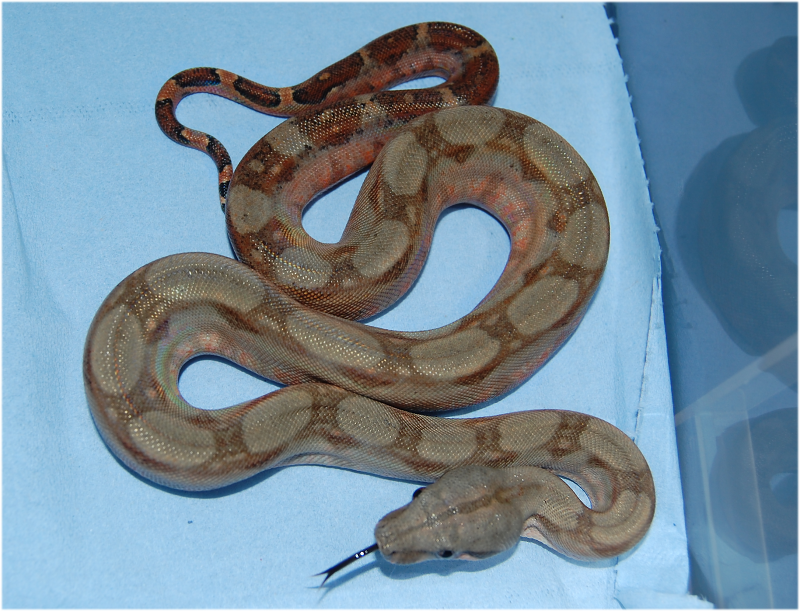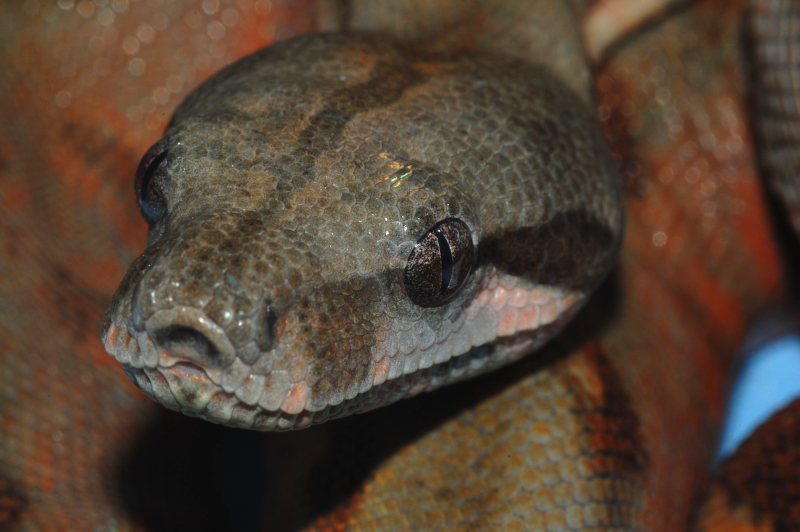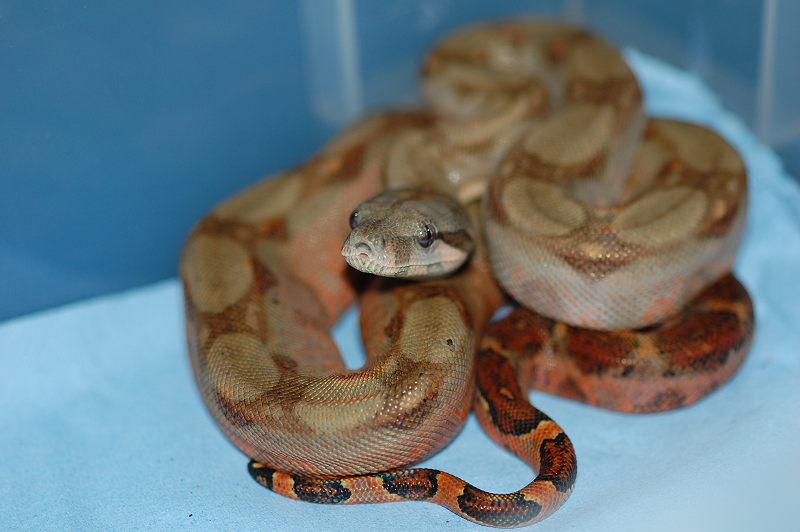Tula_Montage
It's Jager time!
RIP Clementine, my beloved Corn Island boa girlie. She died on the 7th of July 2009 due to massive renal failure. She had started to show signs of ill health on the 20th of June 09. Nothing that was overly serious in my mind at the time. She was going through a bad shed, something which she had never had before. Her skin was horribly wrinkled and looked like leather. She also refused food on two occasions, something that was also completely out of the ordinary. She would normally eat in shed or out of shed and dangling from the rooftops (figure of speech). She then started to become slightly lethargic so off to the vets it was. The first time I was told to take her home and wait for her to shed. I got her home and she did not improve, nor did she shed. I took her back a few days later with increasing worry incase it was some sort of infection. She was sent home again with oral Baytril and critical care and high fat food to tube feed her and hopefully hydrate her and perk her up. She started this medication on the 26th of June and it continued until the 5th of July when I decided enough was enough and stopped. On this day I knew something serious was wrong with her and no amount of critical care was going to bring her back. She was extremely swollen in her kidney area, lethargic, almost completely unresponsive, spinning her head, corking her head into the most strange positions and was almost completely limp. The most worrying symptoms was the fact she was unable to right herself up when placed on her back. She was rushed back to the vet on the 6th of July and I knew then she wasn’t going to get better and IBD was spinning in my mind. She was admitted to the practise but nobody expected her to make it through the night. She was given a blood test when still alive. I got a call late that night to say her white blood cell count was through the roof. The count should have been 2-3000 and it was 36000. Kidney count should be 4-500, hers was 13-1500. I was called around 9.30 that night after the blood test was done to say inclusions had been found in the blood, and I knew then I would never see her again. I was called very early on the 7th of July to be informed that Clementine had died overnight. I had already given permission for them to do an autopsy (as of course you would will ANY unknown illness). After the autopsy was done and all the pathology came back I was informed on the 21st of July that she had indeed died of Inclusion Body disease. RIP my wonderful lassie, you will never be forgotten.
For those who are not aware of IBD or what it is, I will try to explain it as simplistically and factually as possible from my own experience, understanding and research. Inclusion body disease is a viral disease which manifests in captive bred boas and pythons (aka boids). As in the case of the human virus AIDS, IBD is a retro virus and spreads through bodily fluids (ie breeding or through unhygienic contact with faeces or other fluids from infected snakes). The most common transportation of this disease in captivity is through mites. This very dangerous little vector only has to suck the blood from one infected snake to spread it around entire collections. Just before Clementine became ill I had been battling a mite infestation (That came from god knows where as in my 4 years of keeping snakes I have never had mites), and she indeed had mites. Infected mites can spread it to any species or genus of snakes, however there is only conclusive evidence of it physically manifesting in boas and pythons. Colubrids CAN carry the disease but may never ever show the signs or symptoms. However this is when the snake mite can suck the blood from a perfectly physically healthy yet infected colubrid and spread it to boas and pythons.
Mites are a serious pest and MUST be eradicated in the most sever manner possible within captive collections. I cannot stress enough how much stress and grief they have caused me, and they could have possibly infected my ENTIRE collection with IBD due to how quickly they breed and spread from snake to snake. I use front line on the snakes and preventamite in their cages. I soak ALL viv furnishings and plants in bleach, then spray with F10 and finally spray with proventamite. During a mite infestation I would advise you leave all hides and plants etc out of vivs. Instead opt for clean white kitchen towel layers the infested snake can bury or hide in, just long enough for the mites to die off. This makes it easy to see live and dead mites and gives the eggs little chance of survival if you are replacing the kitchen towel every day. I would also advise on washing and hovering all carpets as mites travel a long long way to find their next host. And in that time they will be breeding and laying eggs in your carpets. The next time you have a mite infestation try putting some double sided selotape on your carpets surrounding vivs and see just how many mites will be stuck on it in the morning! Anyway enough about mites, I think my point about how dangerous they are has been made.
At the moment there is no cure for IBD. Once the snake is showing signs and symptoms you can guarantee it will succumb to the disease. Boas are known to be long term asymptomatic carriers of the disease. This means that whilst boas can catch the disease the can harbour it for years before it finally manifests. Whereas pythons tend not to have more than a month once they have caught the disease. Thus why pythons are almost like a canary in a mine shaft when you have a confirmed case of IBD in your collection. I can happily say that my 3 pythons (spotted pythons and a chondro) are perfectly fine almost 2 months since Clementine became ill. This is a very small relief for the time being. When taking the manifestation period into account in regards to boas, it is evident that NO amount of quarantine will ever protect you against IBD coming into your collection. You may have boas that have carried the disease their entire life and NEVER shown symptoms. Clementine could have been born with IBD (as it can spread from mother to babies, just like human aids) and almost 3 years later that is it just staring to rear it’s head. Or she could have caught it from any one of my other snakes brought in over the years when I had a mite infestation.
The point is NOBODY knows where IBD comes from. And how is it possible to track a disease which is sooooo good at hiding. No snake keeper on this planet can claim their collection is free from IBD. The only thing we can do is prevent the spread by adhering to the highest standards of hygiene and care as possible. Ie reduce the risk of the spread of infection by washing all feeding tools and disinfecting your hands between every snake etc. This may seem like common knowledge but ask yourself do you practise these methods between EVERY SINGLE SNAKE? I am guilty of not doing so often in the past when I assumed my snakes were all perfectly healthy and fine. Now, there is no chance of a lapse in my hygiene procedures. Not that I have learnt that lesson the hard way.
Some of the most common signs and symptoms of IBD are stargazing and cork screwing of the head and neck. This generally means inclusions have entered the brain and have cause the snake to have no control over it’s neuro system which includes coordination and movements. Ie why Clementine was not able to flip herself up. Here is a picture to demonstrate. (not of Clementine)
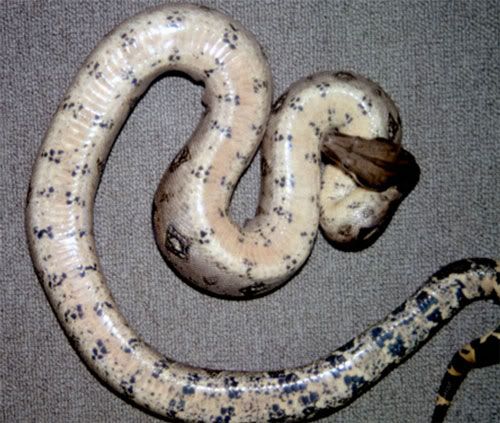
An infected snake may also experience head tremors, chronic regurgitation, the inability the shed, dehydration, anorexia (ie not willing to feed) and secondary infections may develop such as a respiratory infection or pneumonia.
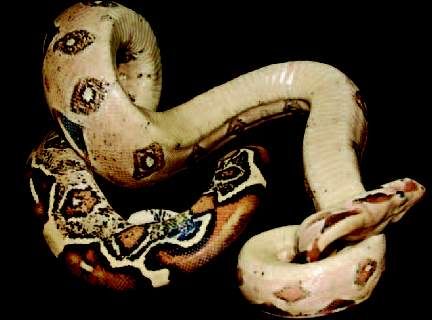
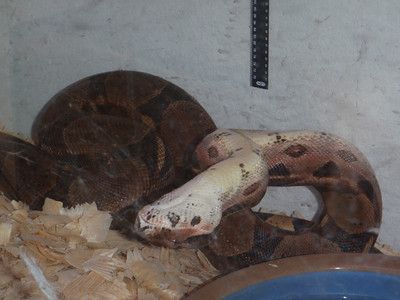
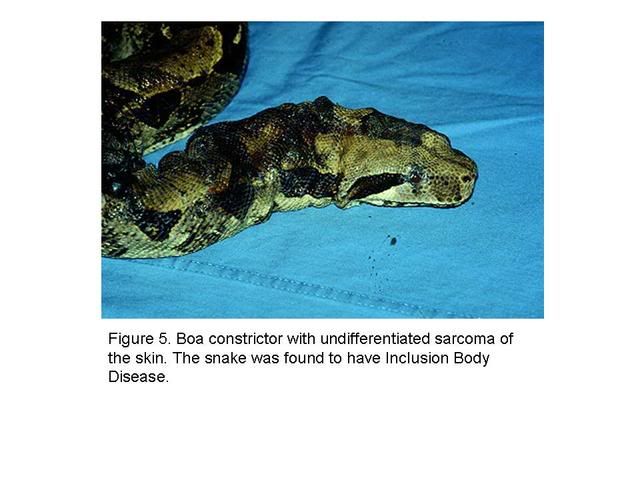
There are no images of Clementine when she was ill. In retrospect I should have documented her illness, but not in a million years did I think it would turn out to be so serious.
There is a chance every single one of my snakes have IBD, and there is a chance that none of them do. But the fact is I have to treat them as infected individuals because you cannot test conclusively for IBD on a live animal without a positive result for inclusions either in the blood or through organ biopsies which are invasive, painful and extremely expensive. A positive result is definitive, but a negative result in a live animal does not mean it is free from IBD. I have had blood tests done on 3 of my other boas and all of them are negative. However this does not mean they don’t still carry the disease. Here is a diagram of a boa who is having an ultrasound guided liver biopsy (which can only be done under anathesia, another risk to add when testing for IBD on live snakes.)
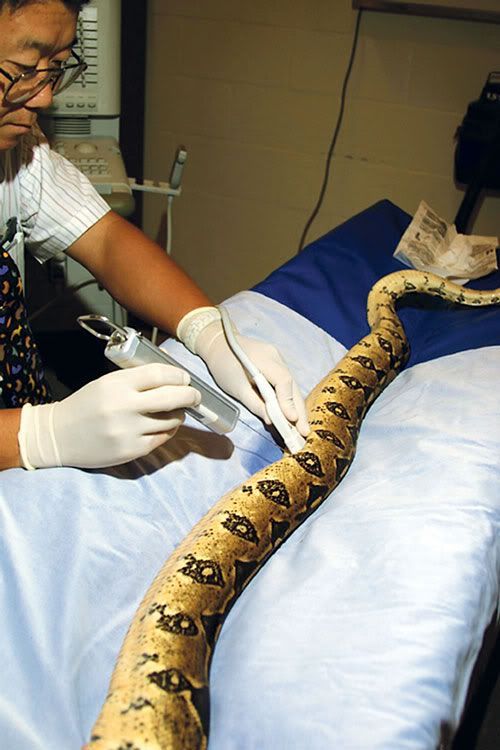
IBD is not a common illness by any means. But I am sure there are a few cases which have not gone public due to the fear of a ruined reputation. Keeping quiet and carrying on like nothing has ever happened is how this disease spreads. And if you are reading this and have ever done such a thing, bow your head in shame! I have no shame in admitting I have had ONE snake die conclusively of IBD. I have nothing to lose from sharing my experience with other people if it helps to prevent this utterly horrific disease. I will NEVER be able to breed, sell or buy snakes until every single snake I currently have is dead and buried. I have two gravid female candoia carinata ready to drop any day now after 8 months gestation. And I will have to keep all of the babies. Sorry to those who were on waiting lists and keep asking about when the girls are due. I cannot risk selling ANYTHING whether they appear to be healthy or not.
I would like to make it clear that in no way shape or form am I laying blame to anyone for the fact I have had one snake die from IBD. How can you trace a disease which can harbour for a boa’s entire lifetime. Was it spread from a snake I no longer have? Was it from a snake I have had for years that was affected by the mites and spread it to Clementine? I have only ever bought from reputable breeders and well known forumites, so that is something to think about.
As for my other snakes, they are ALL acting normally. Absolutely none are showing signs or symptoms of IBD at the moment. All I can do is enjoy each day as it comes with every one of my pet snakes. It saddens me I cannot breed them but I bought them primarily as pets to enjoy, not just to breed so I have not lost out on much. I am just so thankful for the snakes I have, and to lose anymore would simply break my heart. I do not feel the option of euthanizing all my snakes is the right one for me. They all appear fine at the moment however rest assured any that do show symptoms of IBD will be euthanized straight away and autopsied to confirm whether or not they had the disease. I care too much for my snakes to unnecessarily euthanise them all without giving them a chance at life. As said earlier, some boas may carry the disease their entire life and may never show symptoms. That would be the very best possible outcome I could imagine at this moment in time and for the foreseeable future.
Thank you for taking the time to read my post, I am sure it has taken you a while. RIP Clementine, I miss you so very much lassie…
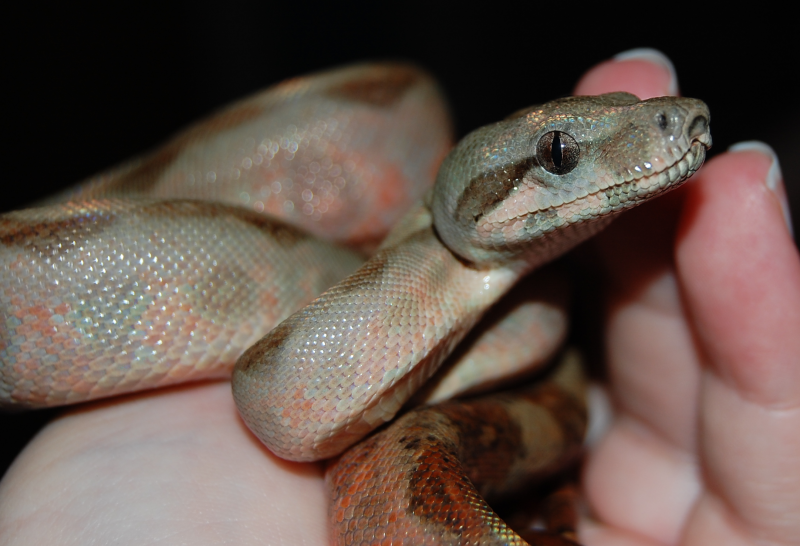
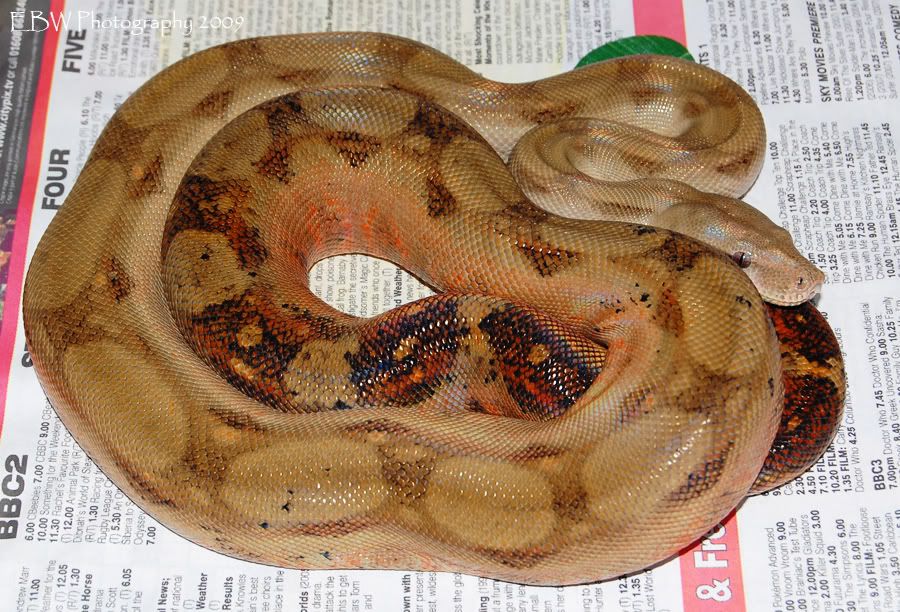

Here is the full autopsy and pathology report from Clementine’s case. Photographed due to my scanner being broken. Note the dates.
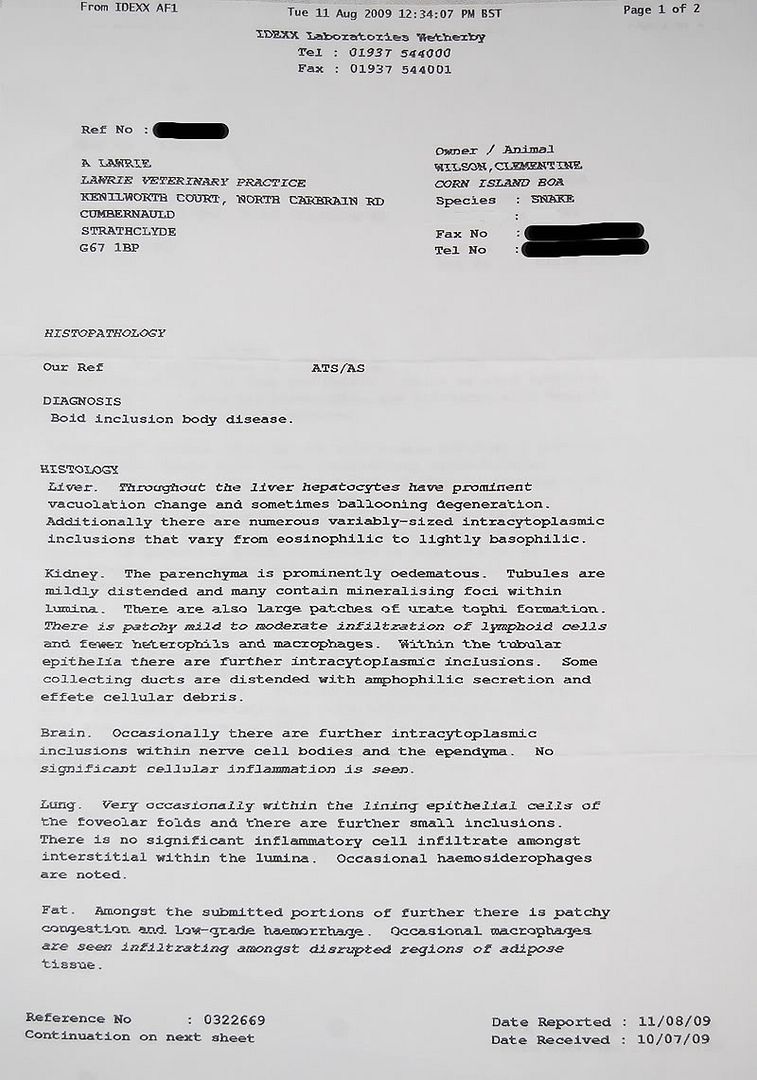
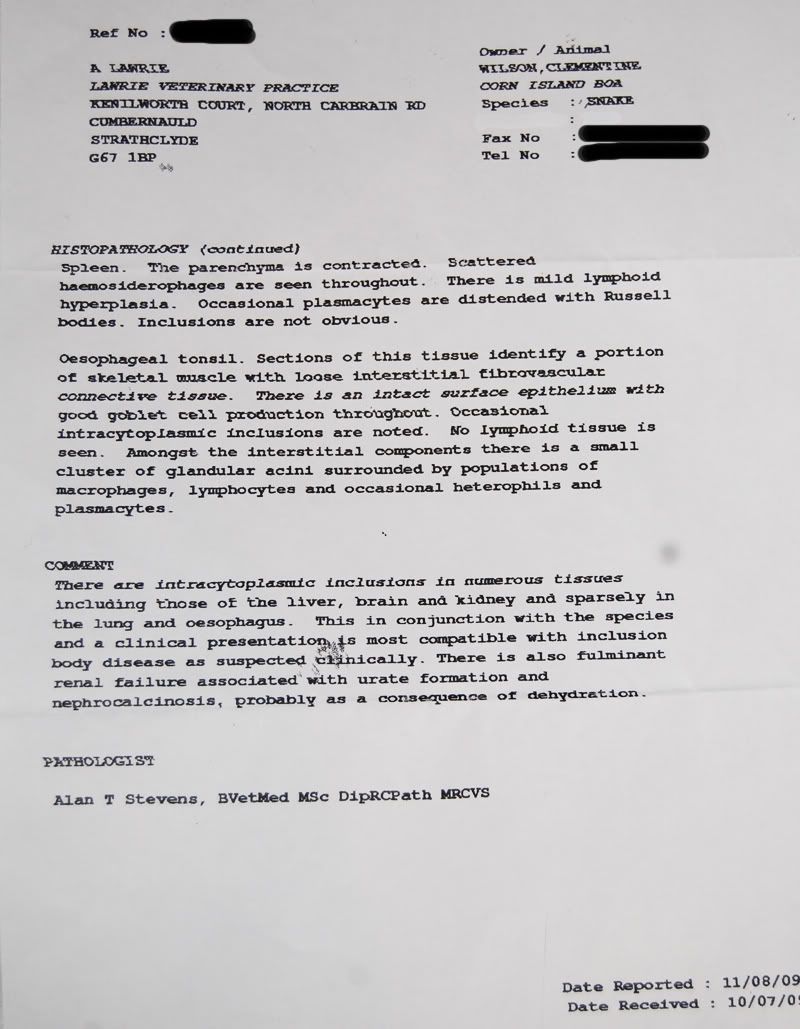
For those who are not aware of IBD or what it is, I will try to explain it as simplistically and factually as possible from my own experience, understanding and research. Inclusion body disease is a viral disease which manifests in captive bred boas and pythons (aka boids). As in the case of the human virus AIDS, IBD is a retro virus and spreads through bodily fluids (ie breeding or through unhygienic contact with faeces or other fluids from infected snakes). The most common transportation of this disease in captivity is through mites. This very dangerous little vector only has to suck the blood from one infected snake to spread it around entire collections. Just before Clementine became ill I had been battling a mite infestation (That came from god knows where as in my 4 years of keeping snakes I have never had mites), and she indeed had mites. Infected mites can spread it to any species or genus of snakes, however there is only conclusive evidence of it physically manifesting in boas and pythons. Colubrids CAN carry the disease but may never ever show the signs or symptoms. However this is when the snake mite can suck the blood from a perfectly physically healthy yet infected colubrid and spread it to boas and pythons.
Mites are a serious pest and MUST be eradicated in the most sever manner possible within captive collections. I cannot stress enough how much stress and grief they have caused me, and they could have possibly infected my ENTIRE collection with IBD due to how quickly they breed and spread from snake to snake. I use front line on the snakes and preventamite in their cages. I soak ALL viv furnishings and plants in bleach, then spray with F10 and finally spray with proventamite. During a mite infestation I would advise you leave all hides and plants etc out of vivs. Instead opt for clean white kitchen towel layers the infested snake can bury or hide in, just long enough for the mites to die off. This makes it easy to see live and dead mites and gives the eggs little chance of survival if you are replacing the kitchen towel every day. I would also advise on washing and hovering all carpets as mites travel a long long way to find their next host. And in that time they will be breeding and laying eggs in your carpets. The next time you have a mite infestation try putting some double sided selotape on your carpets surrounding vivs and see just how many mites will be stuck on it in the morning! Anyway enough about mites, I think my point about how dangerous they are has been made.
At the moment there is no cure for IBD. Once the snake is showing signs and symptoms you can guarantee it will succumb to the disease. Boas are known to be long term asymptomatic carriers of the disease. This means that whilst boas can catch the disease the can harbour it for years before it finally manifests. Whereas pythons tend not to have more than a month once they have caught the disease. Thus why pythons are almost like a canary in a mine shaft when you have a confirmed case of IBD in your collection. I can happily say that my 3 pythons (spotted pythons and a chondro) are perfectly fine almost 2 months since Clementine became ill. This is a very small relief for the time being. When taking the manifestation period into account in regards to boas, it is evident that NO amount of quarantine will ever protect you against IBD coming into your collection. You may have boas that have carried the disease their entire life and NEVER shown symptoms. Clementine could have been born with IBD (as it can spread from mother to babies, just like human aids) and almost 3 years later that is it just staring to rear it’s head. Or she could have caught it from any one of my other snakes brought in over the years when I had a mite infestation.
The point is NOBODY knows where IBD comes from. And how is it possible to track a disease which is sooooo good at hiding. No snake keeper on this planet can claim their collection is free from IBD. The only thing we can do is prevent the spread by adhering to the highest standards of hygiene and care as possible. Ie reduce the risk of the spread of infection by washing all feeding tools and disinfecting your hands between every snake etc. This may seem like common knowledge but ask yourself do you practise these methods between EVERY SINGLE SNAKE? I am guilty of not doing so often in the past when I assumed my snakes were all perfectly healthy and fine. Now, there is no chance of a lapse in my hygiene procedures. Not that I have learnt that lesson the hard way.
Some of the most common signs and symptoms of IBD are stargazing and cork screwing of the head and neck. This generally means inclusions have entered the brain and have cause the snake to have no control over it’s neuro system which includes coordination and movements. Ie why Clementine was not able to flip herself up. Here is a picture to demonstrate. (not of Clementine)

An infected snake may also experience head tremors, chronic regurgitation, the inability the shed, dehydration, anorexia (ie not willing to feed) and secondary infections may develop such as a respiratory infection or pneumonia.



There are no images of Clementine when she was ill. In retrospect I should have documented her illness, but not in a million years did I think it would turn out to be so serious.
There is a chance every single one of my snakes have IBD, and there is a chance that none of them do. But the fact is I have to treat them as infected individuals because you cannot test conclusively for IBD on a live animal without a positive result for inclusions either in the blood or through organ biopsies which are invasive, painful and extremely expensive. A positive result is definitive, but a negative result in a live animal does not mean it is free from IBD. I have had blood tests done on 3 of my other boas and all of them are negative. However this does not mean they don’t still carry the disease. Here is a diagram of a boa who is having an ultrasound guided liver biopsy (which can only be done under anathesia, another risk to add when testing for IBD on live snakes.)

IBD is not a common illness by any means. But I am sure there are a few cases which have not gone public due to the fear of a ruined reputation. Keeping quiet and carrying on like nothing has ever happened is how this disease spreads. And if you are reading this and have ever done such a thing, bow your head in shame! I have no shame in admitting I have had ONE snake die conclusively of IBD. I have nothing to lose from sharing my experience with other people if it helps to prevent this utterly horrific disease. I will NEVER be able to breed, sell or buy snakes until every single snake I currently have is dead and buried. I have two gravid female candoia carinata ready to drop any day now after 8 months gestation. And I will have to keep all of the babies. Sorry to those who were on waiting lists and keep asking about when the girls are due. I cannot risk selling ANYTHING whether they appear to be healthy or not.
I would like to make it clear that in no way shape or form am I laying blame to anyone for the fact I have had one snake die from IBD. How can you trace a disease which can harbour for a boa’s entire lifetime. Was it spread from a snake I no longer have? Was it from a snake I have had for years that was affected by the mites and spread it to Clementine? I have only ever bought from reputable breeders and well known forumites, so that is something to think about.
As for my other snakes, they are ALL acting normally. Absolutely none are showing signs or symptoms of IBD at the moment. All I can do is enjoy each day as it comes with every one of my pet snakes. It saddens me I cannot breed them but I bought them primarily as pets to enjoy, not just to breed so I have not lost out on much. I am just so thankful for the snakes I have, and to lose anymore would simply break my heart. I do not feel the option of euthanizing all my snakes is the right one for me. They all appear fine at the moment however rest assured any that do show symptoms of IBD will be euthanized straight away and autopsied to confirm whether or not they had the disease. I care too much for my snakes to unnecessarily euthanise them all without giving them a chance at life. As said earlier, some boas may carry the disease their entire life and may never show symptoms. That would be the very best possible outcome I could imagine at this moment in time and for the foreseeable future.
Thank you for taking the time to read my post, I am sure it has taken you a while. RIP Clementine, I miss you so very much lassie…



Here is the full autopsy and pathology report from Clementine’s case. Photographed due to my scanner being broken. Note the dates.






